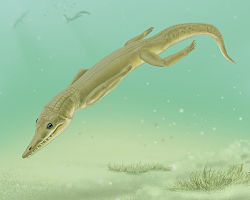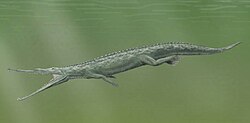Phytosaur
Phytosaurs are an extinct group of large semi-aquatic Upper Triassic archosaurs.
| Phytosaurs Temporal range: Triassic, 242–201 mya
| |
|---|---|

| |
| Skeleton of Redondasaurus at the Carnegie Museum of Natural History | |
| Scientific classification | |
| Unrecognized taxon (fix): | Phytosauria |
| Genera | |
| |
| Synonyms | |
|
Parasuchia Huxley, 1875 | |
Phytosaurs were long-snouted and heavily armoured, bearing a remarkable resemblance to modern crocodiles in size, appearance, and lifestyle.[1] This is an example of convergence or parallel evolution.
The name 'phytosaur' means 'plant reptile': the first fossils of phytosaurs were mistakenly thought to belong to plant eaters. The sharp teeth in phytosaur jaws clearly show they were predators.
Although phytosaurs were not true crocodilians, they were more closely related to the crocodilians than to other modern reptiles.[2] Crocodiles did not become phytosaur-like until the Lower Jurassic. "Consensus generally places phytosaurs as basal crurotarsans, possibly the basal-most group".[3]
Phytosaurs had a nearly global distribution. Fossils have been recovered from Europe, North America, India, Morocco, Thailand, Brazil and Madagascar.
Phytosaur Media
Illustration of two Smilosuchus species, illustrating brachyrostral and dolichorostral snout types
References
- ↑ Benton M.J. 1990. The reign of the reptiles. Crescent, New York. p75
- ↑ Jones, Andrew S.; Butler, Richard J. 2018. A new phylogenetic analysis of Phytosauria (Archosauria: Pseudosuchia) with the application of continuous and geometric morphometric character coding. PeerJ. 6: e5901. [1]
- ↑ Brusatte, Stephen L. et al 2010. The higher-level phylogeny of Archosauria (Tetrapoda: Diapsida). Journal of Systematic Palaeontology. 8: 1, 3–47. [2]









